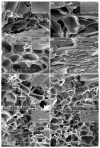Design and Fabrication of Bilayer Hydrogel System with Self-Healing and Detachment Properties Achieved by Near-Infrared Irradiation
- PMID: 30970913
- PMCID: PMC6431838
- DOI: 10.3390/polym9060237
Design and Fabrication of Bilayer Hydrogel System with Self-Healing and Detachment Properties Achieved by Near-Infrared Irradiation
Abstract
A novel kind of graphene oxide (GO)-containing bilayer hydrogel system with excellent self-healing and detachment properties stimulated by near-infrared irradiation is successively fabricated via a two-step in situ free radical polymerization. In addition to high mechanical strength, as components of a bilayer hydrogel system, a poly N,N-dimethylacrylamide (PDMAA) layer with 3 mg/mL GO and a poly N-isopropylacrylamide (PNIPAm) layer with 3 mg/mL GO exhibits firm interface bonding. GO in a PDMAA layer transforms under a near-infrared laser into heat, which promotes mutual diffusion of hydrogen bonds and realizes a self-healing property. The irradiation of near infrared laser results in the temperature of PNIPAm layer being higher than the volume phase transition temperature, reducing the corresponding biological viscidity and achieving detachment property. The increase of GO content enhances the self-healing degree and detachment rate. The bilayer hydrogel system fabricated via mold design combines characteristics of PDMAA layer and PNIPAm layer, which can be treated as materials for medical dressings, soft actuators, and robots.
Keywords: bilayer hydrogel system; detachment rate; photothermal energy transformation efficiency; self-healing degree.
Conflict of interest statement
The authors declare no conflict of interest.
Figures










References
-
- Dumitrescua A.M., Slatineanua T., Poiatab A., Iordana A.R., Mihailescuc C., Palamarua M.N. Advanced composite materials based on hydrogels andferrites for potential biomedical applications. Colloids Surf. A Physicochem. Eng. Asp. 2014;455:185–194. doi: 10.1016/j.colsurfa.2014.04.055. - DOI
-
- Li L., Smitthipong W., Zeng H.B. Mussel-inspired hydrogels for biomedicaland enviromental applications. Polym. Chem. 2015;6:353–358. doi: 10.1039/C4PY01415D. - DOI
-
- Bakarich S.E., Gorkin R., Naficy S., Gately R., Panhuis M.I.H., Spinks G.M. 3D/4D printing hydrogel composites: A pathway to functional devices. MRS Adv. 2016;1:521–526. doi: 10.1557/adv.2015.9. - DOI
LinkOut - more resources
Full Text Sources

